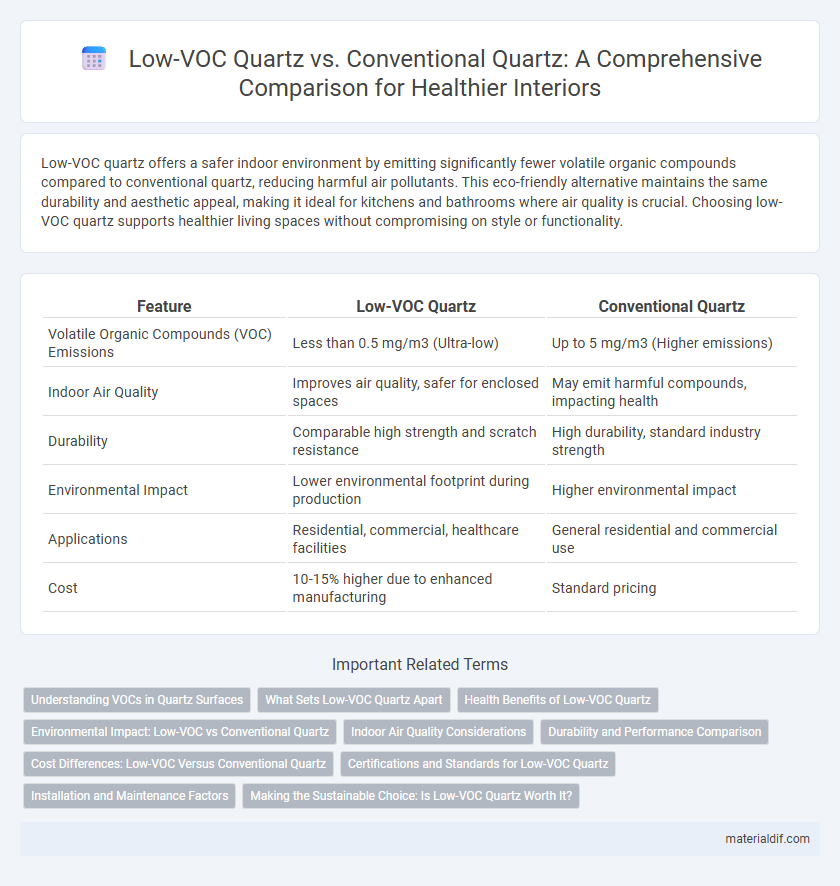Low-VOC quartz offers a safer indoor environment by emitting significantly fewer volatile organic compounds compared to conventional quartz, reducing harmful air pollutants. This eco-friendly alternative maintains the same durability and aesthetic appeal, making it ideal for kitchens and bathrooms where air quality is crucial. Choosing low-VOC quartz supports healthier living spaces without compromising on style or functionality.
Table of Comparison
| Feature | Low-VOC Quartz | Conventional Quartz |
|---|---|---|
| Volatile Organic Compounds (VOC) Emissions | Less than 0.5 mg/m3 (Ultra-low) | Up to 5 mg/m3 (Higher emissions) |
| Indoor Air Quality | Improves air quality, safer for enclosed spaces | May emit harmful compounds, impacting health |
| Durability | Comparable high strength and scratch resistance | High durability, standard industry strength |
| Environmental Impact | Lower environmental footprint during production | Higher environmental impact |
| Applications | Residential, commercial, healthcare facilities | General residential and commercial use |
| Cost | 10-15% higher due to enhanced manufacturing | Standard pricing |
Understanding VOCs in Quartz Surfaces
Low-VOC quartz surfaces emit significantly fewer volatile organic compounds compared to conventional quartz, enhancing indoor air quality and reducing health risks. VOCs in quartz are primarily released from resin binders and adhesives used during manufacturing, making low-VOC options preferable for sensitive environments. Selecting low-VOC quartz not only supports eco-friendly building standards but also ensures safer living spaces without compromising durability or aesthetics.
What Sets Low-VOC Quartz Apart
Low-VOC quartz is distinguished by its significantly reduced emissions of volatile organic compounds compared to conventional quartz, promoting improved indoor air quality and reduced health risks. This eco-friendly material contains specialized resins that emit fewer harmful chemicals during fabrication and installation. The enhanced environmental profile of low-VOC quartz makes it a preferred choice for sustainable building projects and health-conscious environments.
Health Benefits of Low-VOC Quartz
Low-VOC quartz significantly reduces indoor air pollution by emitting fewer volatile organic compounds compared to conventional quartz, enhancing respiratory health and reducing allergy risks. Exposure to low-VOC quartz surfaces minimizes headache, dizziness, and irritation incidents commonly linked with formaldehyde and other harmful chemicals in traditional quartz. Choosing low-VOC quartz supports healthier indoor environments, particularly benefiting individuals with asthma or chemical sensitivities.
Environmental Impact: Low-VOC vs Conventional Quartz
Low-VOC quartz significantly reduces indoor air pollution by emitting fewer volatile organic compounds compared to conventional quartz, contributing to healthier living environments. Conventional quartz often contains higher levels of VOCs, which can release toxic gases during installation and everyday use, negatively impacting air quality. Choosing low-VOC quartz minimizes the environmental burden by lowering harmful emissions and enhancing indoor environmental health.
Indoor Air Quality Considerations
Low-VOC quartz significantly improves indoor air quality by emitting fewer volatile organic compounds compared to conventional quartz, reducing the risk of respiratory irritation and long-term health issues. The low emissions contribute to a safer environment in kitchens and bathrooms, especially important in poorly ventilated spaces. Choosing low-VOC quartz supports compliance with indoor air quality standards such as LEED and WELL certifications, promoting healthier living conditions.
Durability and Performance Comparison
Low-VOC quartz surfaces exhibit enhanced durability due to reduced emission of volatile organic compounds, maintaining structural integrity and resisting wear better than conventional quartz. Their low VOC composition contributes to improved performance in moisture and stain resistance, ensuring longevity in high-use environments such as kitchens and bathrooms. Conventional quartz may release higher VOC levels, potentially compromising indoor air quality, while low-VOC options optimize both environmental safety and surface endurance.
Cost Differences: Low-VOC Versus Conventional Quartz
Low-VOC quartz typically incurs higher upfront costs compared to conventional quartz due to the advanced manufacturing processes and environmentally friendly materials involved. Despite the initial price premium, low-VOC quartz offers long-term savings through improved indoor air quality and potential reductions in health-related expenses. Conventional quartz remains a more affordable option but lacks the environmental and health benefits associated with low-VOC alternatives.
Certifications and Standards for Low-VOC Quartz
Low-VOC quartz surfaces comply with strict environmental certifications such as GREENGUARD Gold and NSF/ANSI 342, ensuring reduced emissions of volatile organic compounds and enhanced indoor air quality. Conventional quartz often lacks these certifications, resulting in higher VOC levels that may impact health and safety. Compliance with ISO 16000 and California Section 01350 standards further validates low-VOC quartz as a sustainable and safe choice for residential and commercial applications.
Installation and Maintenance Factors
Low-VOC quartz offers a safer installation environment by reducing harmful chemical emissions compared to conventional quartz, which often contains higher levels of volatile organic compounds. Maintenance of low-VOC quartz surfaces involves fewer toxic cleaners, prolonging surface integrity and ensuring better indoor air quality over time. Both types require similar routine care, but low-VOC options enhance long-term health and safety during installation and daily upkeep.
Making the Sustainable Choice: Is Low-VOC Quartz Worth It?
Low-VOC quartz contains fewer volatile organic compounds, significantly reducing indoor air pollution and improving air quality compared to conventional quartz. Its manufacturing process emphasizes environmental sustainability by minimizing harmful emissions and promoting safer living spaces. Choosing low-VOC quartz supports eco-friendly home design while maintaining the durability and aesthetic appeal that quartz countertops are known for.
Low-VOC Quartz vs Conventional Quartz Infographic

 materialdif.com
materialdif.com